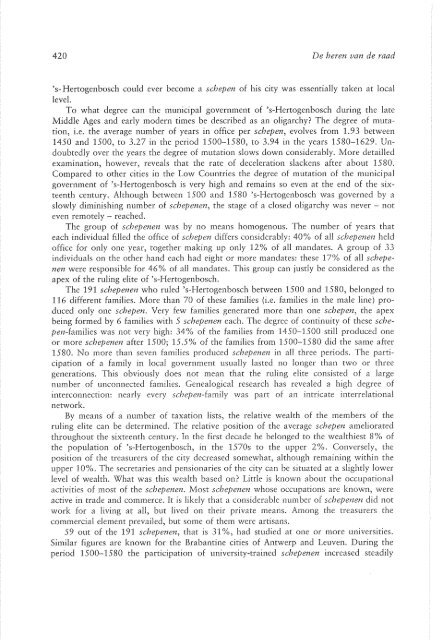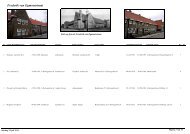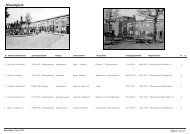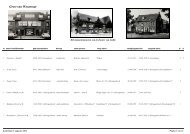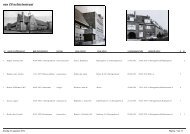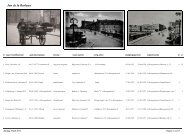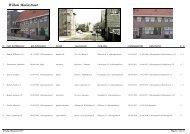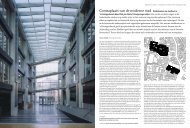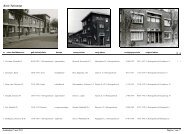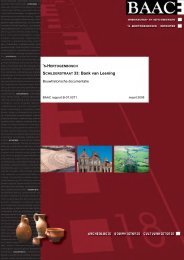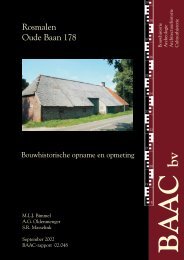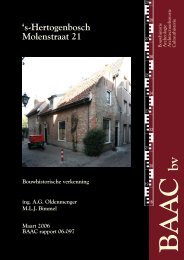- Page 2 and 3:
Bestuurlijke elite van 's-Hertogenb
- Page 4 and 5:
voor mijn ouders voor Inge
- Page 6 and 7:
AFKORTINGEN CONVENTIES ONGEPUBLICEE
- Page 8 and 9:
8. FINANCIEEL-ECONOMISCHE POSITIE V
- Page 10 and 11:
CONVENTIES In deze studir staan de
- Page 12 and 13:
IV Heren van de wad ARCHIEF ILLUSTR
- Page 14 and 15:
GEPUBLICEERDE BRONNEN EN LITERATUUR
- Page 16 and 17:
Heren van de raad LITERATUUR AA, A.
- Page 18 and 19:
Heren van de raad kundige kaart val
- Page 20 and 21:
X11 Heren van de raad 185. DELMOTTE
- Page 22 and 23:
XIV Heren van de raad GOOSSENS, TH.
- Page 24 and 25:
XVI Heren van de raad HOPPENBKOUWER
- Page 26 and 27:
XVJII Heren van de raad J.AAR, R. V
- Page 28 and 29:
XX Heren van de raad meerderde besc
- Page 30 and 31:
XXII Heren van de raad SASSE VAN YS
- Page 32 and 33:
XXIV Heren van de raad Nethrriands
- Page 34 and 35:
XXVI Heren van de raad de inuoeri~i
- Page 36 and 37:
2 Heren vapz de raad hemelryck [en]
- Page 38 and 39:
4 Heren van de raad Arisroteles en
- Page 40 and 41:
6 Heren van de raad beklagen de Bos
- Page 42 and 43:
8 Heren van de raad ai van patricia
- Page 44 and 45:
10 Heren van de raad verschijnen, h
- Page 46:
12 Heren van de raad het mogelijk o
- Page 49 and 50:
18 Heren van de raad opzichte van d
- Page 51 and 52:
20 Heren van de raad AFBEELDING 2.
- Page 53 and 54:
22 Heren van de raad cius de stad i
- Page 55 and 56:
24 Neren van de raad lycke meer ste
- Page 57 and 58:
26 Heren van de raad Tekening: Mirj
- Page 59 and 60:
2 8 Heren van de raad herhaaldelijk
- Page 61 and 62:
3 0 Heren van de raad dwingen, was
- Page 63 and 64:
3 2 arochiële indeling van 1569 Te
- Page 65 and 66:
34 Heren van de rand van 's-~ertoge
- Page 67 and 68:
3 6 Heren var2 de raad poorterschap
- Page 69 and 70:
3 8 Heren van de raad worden, nadat
- Page 71 and 72:
lossen" Heren wart de raad Gegevens
- Page 73 and 74:
42 Heren van de raad periode aantal
- Page 75 and 76:
44 Heren van de raad verloop van he
- Page 77 and 78:
hoofdstuk 3 De omvang van de bevolk
- Page 79 and 80:
48 Heren wan de raad jaar intra mur
- Page 81 and 82:
5 O Heren van de raad intra muros e
- Page 83 and 84:
52 Heren van de raad Wat leert ons
- Page 85 and 86:
54 Heren van de raad zettingen aang
- Page 87 and 88:
5 6 Heren wan de raad de drie ander
- Page 89 and 90:
58 Heren van de vaad Inkomste van F
- Page 91 and 92:
6 O Heren van de raad I GRAFIEK 3.1
- Page 93 and 94:
Heren van de raad erbij kan het al
- Page 95 and 96:
64 Heren van de raad GRAFIEK 3.3. A
- Page 97 and 98:
6 6 Heren van de raad jaartal aard
- Page 99 and 100:
6 8 Heren van de raad inwoners, het
- Page 101 and 102:
Heren van de raad De aantallen geko
- Page 103 and 104:
72 Heren van de raad Rijnsgulden (x
- Page 105 and 106:
74 Hererz van de raad De fluctuatie
- Page 107 and 108:
76 Hereit van de raad I. Riinsgulde
- Page 109 and 110:
ORG
- Page 111 and 112:
Heren van de raad en kapitaal en da
- Page 113 and 114:
84 Heren van de raad nederlaag erke
- Page 115 and 116:
8 6 Heren van de raad af te tekenen
- Page 117 and 118:
8 8 Neren van de raad van Den Bossc
- Page 119 and 120:
90 Heren van de raad de schepenen,
- Page 121 and 122:
92 Heren van de raad Hoewel langs v
- Page 123 and 124:
94 Heren van de raad ragen voor als
- Page 125 and 126:
Heren van de rand laten ondergeschi
- Page 127 and 128:
98 Heren van de rand de stad afslui
- Page 129 and 130:
Heren van de raad verplicht lid zij
- Page 131 and 132:
Heren van de raad 4.3.3.1. de posit
- Page 133 and 134:
104 Heren van de raad kiezen. Het m
- Page 135 and 136:
106 Heren van de raad vastgesteld,
- Page 137 and 138:
108 Heren van de raad reden werd di
- Page 139 and 140:
110 Heren uaiz de raad van 1562 tot
- Page 141 and 142:
112 Heren van de raad JAN FEB MRT A
- Page 143 and 144:
aadsvergaderingen te zeggen. Slecht
- Page 145 and 146:
Heren wan de raad uitstel onmogelij
- Page 147 and 148:
118 Heren van de raad datum feestda
- Page 149 and 150:
aantal dagen 270 282 276 268 225 aa
- Page 151 and 152:
122 Hererz van de rand Jan van Arke
- Page 153 and 154:
124 Heren umz de raad aantal jaar r
- Page 155 and 156:
126 Heren van de raad gedeputeerde
- Page 157 and 158:
128 Heren van de raad poorter had o
- Page 159 and 160:
130 Heren wan de raad Met betrekkin
- Page 161 and 162:
132 Heren van de raad 5,s aanwezig
- Page 163 and 164:
134 Heren van de raad in de stadsre
- Page 165 and 166:
136 Heren van de raad geen gehoor g
- Page 167 and 168:
138 Heren van de raad AANTAL niet J
- Page 169 and 170:
140 Heren van de raad sterk. Door h
- Page 171 and 172:
142 Heren van de raad maal zij in h
- Page 173 and 174:
144 Heren vau de raad Ambachten 147
- Page 175 and 176:
146 Heren van de raad innemen. Dat
- Page 177 and 178:
148 Heren van de raad van de platti
- Page 179 and 180:
150 Heren van de raad die door de e
- Page 181 and 182:
152 Heren van de raad raadsvergader
- Page 183 and 184:
Tussen 1500 en 1580 werd de stad 's
- Page 185 and 186:
156 Heren van de raad Over de groen
- Page 187 and 188:
Heren van de raad te roepenu. De co
- Page 189 and 190:
160 Heren van de raad Het raadhuis
- Page 191 and 192:
162 Heren van de raad eerste en twe
- Page 193 and 194:
164 Heren van de raad Als regel mag
- Page 195 and 196:
166 Heren van de raad Schepenen, ge
- Page 197 and 198:
168 Heren van de raad 27 november 1
- Page 199 and 200:
170 Heren van de raad door de drie
- Page 201 and 202:
6.2.1. INTERNE ZAKEN Heren van de r
- Page 203 and 204:
174 Heren van de raad verbod om lan
- Page 205 and 206:
176 Heren van de raad en herhaaldel
- Page 207 and 208:
Heren vaz de raad gearresteerd, bek
- Page 209 and 210:
180 Heren van de raad deze handelwi
- Page 211 and 212:
182 Heren van de raad lid: Deselve
- Page 213 and 214:
184 Heren van de raad ambachtsgilde
- Page 215 and 216:
186 Heren van de raad rens; nopende
- Page 217 and 218:
AFBEELDING 6. Een briefje met de sc
- Page 219 and 220:
Heren van de raad partijen geaccept
- Page 221 and 222:
192 Heren uau de raad gehele standp
- Page 223 and 224:
194 Heren van de raad toonden schep
- Page 225 and 226:
196 Heren van de raad lid trok zich
- Page 227 and 228:
Heren van de raad Bruessele ende td
- Page 229 and 230:
200 Heren van de raad gezamenlijk o
- Page 231 and 232:
202 Heren van de raad het geheim co
- Page 233 and 234:
Heren van de raad 6.3.3.1. verkiezi
- Page 235:
206 Heren van de rand WEESMEESTERS
- Page 238 and 239:
212 Heren van de raad aspecten zal
- Page 240 and 241:
214 Heren van de rand waarbij van e
- Page 242 and 243:
216 Heren van de raad groepen namen
- Page 244 and 245:
218 Heren van de raad troebelen van
- Page 246 and 247:
220 Heren uatz de raad drie andere
- Page 248 and 249:
222 Heren van de raad nominatie, in
- Page 250 and 251:
224 Heren van de raad nabij Brussel
- Page 252 and 253:
226 Hcven van de raad functioneerde
- Page 254 and 255:
Heren van de raad verschaffen'". De
- Page 256 and 257:
230 Heren van de raad voorgezeten d
- Page 258 and 259:
232 Heren van de raad gemiddeld aan
- Page 260 and 261:
234 Heren van de raad A, per decenn
- Page 262 and 263:
236 Heren van de raad 1450-1499 tel
- Page 264 and 265:
238 Heren van de raad Na de ontwikk
- Page 266 and 267:
240 Heren van de raad dertigste jaa
- Page 268 and 269:
242 Heren van de raad nen op een le
- Page 270 and 271:
244 Heren van de raad vanaf 1548 st
- Page 272 and 273:
24 6 Heren van de raad ouderdom en
- Page 274 and 275:
24 8 Hereiz wart de raad aantal aan
- Page 276 and 277:
250 Heren wart de raad decennium va
- Page 278 and 279:
252 Heren van de raad hertogdom Bra
- Page 280 and 281:
254 Heren van de raad maakten de be
- Page 282 and 283:
256 Heren van de raad Wolf (184) en
- Page 284 and 285:
258 Hereit van de raad ontstond er
- Page 286 and 287:
260 Heren van de raad verkiezingen
- Page 288 and 289:
262 Heren van de raad heid in het b
- Page 290 and 291:
264 Heren van de raad doorstroming
- Page 292 and 293:
deze Ghysbert Hollander na het over
- Page 294 and 295:
268 Heren van de raad gemiddeld gen
- Page 296 and 297:
270 Heren van de raad van buiten de
- Page 298 and 299:
272 Heren van de raad Kaas Raassen
- Page 300 and 301:
Heren van de raad AFBEELDING 9. Jor
- Page 302 and 303:
Albert Ketheler (R40) Henrick van U
- Page 304 and 305:
278 Heren van de raad Uit een brief
- Page 306 and 307:
280 Heren ualz de raad andere stede
- Page 308 and 309:
Heren uan de raad stellen. In princ
- Page 310 and 311:
284 I-leren van de raad Tussen 1500
- Page 312 and 313:
286 Neren van de raad Een belangrij
- Page 314 and 315:
288 Hereu van de raad lening van 15
- Page 316 and 317:
Heren van de raad In deze paragraaf
- Page 318 and 319:
292 Heren van de raad Hezeacker geh
- Page 320 and 321:
Otto Back in 1505 schepen van 's-He
- Page 322 and 323:
296 Heren van de rand FREQUENTIE O
- Page 324 and 325:
1547 wijst opnieuw uit dat die lijs
- Page 326 and 327:
zestiende eeuw, is het aantal polit
- Page 328 and 329:
302 Heren van de raad meer perifeer
- Page 330 and 331:
3 04 Heren van de raad straat en be
- Page 332 and 333:
306 Heren van de raad Ghysbert van
- Page 334 and 335:
308 Heren van de rand te kunnen bet
- Page 336 and 337:
310 Heren van de raad vanzelfspreke
- Page 338 and 339:
312 Heren van de raad in de gedwong
- Page 340 and 341:
314 Heren van de raad bestuurlijke
- Page 342 and 343:
316 Heren van de raad zetting van 1
- Page 344 and 345:
318 Heyen van de raad doormaakten,
- Page 346 and 347:
320 Heren van de raad bacht behoord
- Page 348 and 349:
322 Heren va?z de rand Raas Kaassen
- Page 350 and 351:
324 Neren uaiz de raad zijn knecht
- Page 352 and 353:
Heren van de raad van Brabant, de s
- Page 354 and 355:
Vanaf de late middeleeuwen is er sp
- Page 356 and 357:
330 Keren van de raad onderwijs dat
- Page 358 and 359:
332 Heren van de raad In werkelijkh
- Page 360 and 361:
3 34 Heren van de raad Leuven benef
- Page 362 and 363:
336 Heren van de raad ander dat voo
- Page 364 and 365:
Heren ua7z de raad waaronder bijvoo
- Page 366 and 367:
340 Heren van de raad teruggevonden
- Page 368 and 369:
342 Heren van de raad aantal studen
- Page 370 and 371:
344 Heren van de raad conclusie nog
- Page 372 and 373:
346 Heren van de raad 1504-1507' en
- Page 374 and 375:
348 Heren wan de raad Buscoducensis
- Page 376 and 377:
350 Heren VUE de raad en ander leid
- Page 378 and 379:
352 Heren van de raad percentage sc
- Page 380 and 381:
354 Heren van de raad geweest, de g
- Page 382 and 383:
Heren van de raad lezen dat verrewe
- Page 384 and 385:
Heren van de raad lijn, waarvan de
- Page 386 and 387:
360 Heren van de raad twee van de v
- Page 388 and 389:
deel van de academisch gevormde sec
- Page 390 and 391:
Heren van de raad uitzonderingen na
- Page 392 and 393:
Elke samenleving bestaat uit groepe
- Page 394 and 395:
368 Heren wan de raad periode gemid
- Page 396 and 397: 370 Heren van de raad recruteringsg
- Page 398 and 399: 3 72 Heren van de raad 1. proosten
- Page 400 and 401: 3 74 Heren van de raad B-nr. 252 06
- Page 402 and 403: 3 76 Hereiz van de raad evenwel pas
- Page 404 and 405: 3 79 Heren van de rand alsoe inde m
- Page 406 and 407: 380 Heren wan de raad kan. Wessel v
- Page 408 and 409: 382 Heren van de raad gezworenen hu
- Page 410 and 411: 3 84 Heren van de raad nadat hij aa
- Page 412 and 413: Heren van de wad maaltijd bij zoude
- Page 414 and 415: 388 Heren van de raad regelmatig ee
- Page 416 and 417: 390 Heren van de raad die locatie z
- Page 418 and 419: 392 Heren van de raad maaltijdcyclu
- Page 420 and 421: 3 94 Heren van de rand hebben volda
- Page 422 and 423: 396 Heren van de raad algemene univ
- Page 424 and 425: 398 Heren van de raad peiljaar lede
- Page 426 and 427: 400 Heren ualz de raad grens toch d
- Page 428 and 429: Neren van de raad broederschapsmaal
- Page 430 and 431: 404 Heren van de raad later geen pe
- Page 432 and 433: Heren wan de raad kernleden: zeven
- Page 434 and 435: Heren van de raam AFBEELDING 11. Po
- Page 436 and 437: 410 Heren van de raad binnen 17 18
- Page 438 and 439: 412 Heren van de raad De kern van d
- Page 440 and 441: 414 Heren van de raad Hoewel de rol
- Page 442 and 443: 416 Heren van de raad Leuven, al ve
- Page 444 and 445: The city of 's-Hertogenbosch was on
- Page 449 and 450: Voor een vijftal regeringsjaren, 14
- Page 451 and 452: Bijlage 1 A. Jan van Arkel E. Jan M
- Page 453 and 454: Bijlage 1 A. Jan van Viaderacken (1
- Page 455 and 456: Bijlage 1
- Page 457 and 458: A. Willen de Borchgreve (32) F. Arn
- Page 459 and 460: Bijlage 1 Roelof de Bever (21) \7/
- Page 461 and 462: Bijlage 1 ". A U;~VA,U~,,, wiivnmr.
- Page 463 and 464: Bijlage 1 .~- A. 8. D: E. Henrick B
- Page 465 and 466: Voor de vijf schepenstoelen tussen
- Page 467 and 468: Deel 111 van deze studie is grotend
- Page 469 and 470: Bijlage 3 1515 JanvanErp + 1516 151
- Page 471 and 472: Bijlage 3 t 7-1534' [l] SCHEPEN 152
- Page 473 and 474: Bijlage 3 449 12 PETER VA t 19-8-15
- Page 475 and 476: Bijlage 3 451 23 11-10-1519 t 13-4-
- Page 477 and 478: Bijlage 3 35 GOESSEN VAN BRECHT t 2
- Page 479 and 480: Bijlage 3 SY2 55; VAN SASSE VAN YSS
- Page 481 and 482: Bijlage 3 457 t 2-9-1526 [l] SECRET
- Page 483 and 484: Bijlage 3 459 van Grimbergen. Hij i
- Page 485 and 486: Bijlage 3 Blaarthem. VAN SASSE VAN
- Page 487 and 488: Bijlage 3 84 GOYAERT V t 1587 [i] S
- Page 489 and 490: Bijlage 3 [l] RENTMEESTER-IN-NAAM 1
- Page 491 and 492: Bijlage 3 467 063. [S] O: Boudewyn
- Page 493 and 494: Bijlage 3 469 t 1517 [l] SCHEPEN 14
- Page 495 and 496: Bijlage 3 471 SY2 381; BEELAERTS VA
- Page 497 and 498:
Bijlage 3 473 " I 1518 t 13-5-1573
- Page 499 and 500:
Bijlage 3 0 t 8-8-1521 [l] SCHEPEN
- Page 501 and 502:
Bijlage 3 " 1506-1507 t 28-6-1570 t
- Page 503 and 504:
Bijlage 3 4 79 " 1494-1497 t 17-1-1
- Page 505 and 506:
180 NICOLAES V t voor 1587 [l] SCHE
- Page 507 and 508:
Bijlage 3 483 111 SCHEPEN 1515. [2]
- Page 509 and 510:
Bijlage 4 GAH OA B15 GAH OA B16 GAH
- Page 511 and 512:
O schepen o schepen, overleden tijd
- Page 513 and 514:
Bijlage 5 150 1 2 3 4 5 6 7 0123456
- Page 515 and 516:
(3) uit hofkringen (?); hofzangers;
- Page 517 and 518:
Bijlage 6 naam inschrijving Achelen
- Page 519 and 520:
Bijlage 6 naam Bie, Henrick Herman
- Page 521 and 522:
Bijlage 6 10 Cleve, Nicolaes van CL
- Page 523 and 524:
Bijlage 6 naam Eyck, Gerit Gerit va
- Page 525 and 526:
Bijlage 6 Heeren, Filips Peter Heze
- Page 527 and 528:
Bijlage 6 naam inschrijving Lieshou
- Page 529 and 530:
Bijlage 6 naam Noot, Henrick vander
- Page 531 and 532:
naam Scaeck, Frederick Scarley, Jan
- Page 533 and 534:
naam iiischrijving Veer, Everaert d
- Page 535 and 536:
In deze index zijn personen en geog
- Page 537 and 538:
Index Bergen, Heilwich van "R17 Ber
- Page 539 and 540:
Index Breugel, Albert van "38 Breug
- Page 541 and 542:
Index Deventer 399, "B192 Deventer,
- Page 543 and 544:
Index 216, 217, 244, 245, 249, 255,
- Page 545 and 546:
Hedel, Jan van (91, B196) 273, ' 92
- Page 547 and 548:
Index Kemp, Jan "107 Kemp, Jan (108
- Page 549 and 550:
Index 525 Maes, Henrick "R41 Mallan
- Page 551 and 552:
Inden Oems, Jan "R49 Oems, Wouter (
- Page 553 and 554:
Index 529 Rosalis, Jan "125 Rosalis
- Page 555 and 556:
Index Tongerlo 400, "B225, "B295, "
- Page 557 and 558:
Index Wyel, Johanna vanden "124 Wye
- Page 559:
Errata pagina 8 pagina 3 1 pagina 8


